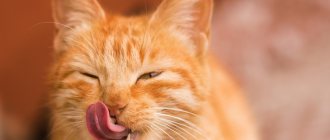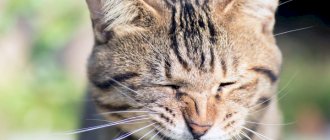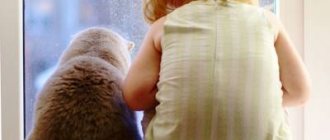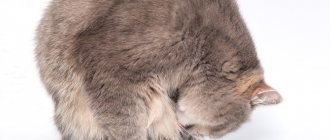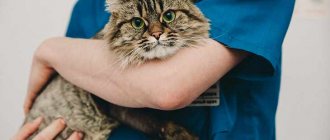Inexperienced owners perceive the birth of a cat as something very complex and large-scale. Anxiety develops into panic if after childbirth, when the young mother constantly meows, gets nervous and “throws about.” It is quite logical to assume that the cat is in pain and needs help. Let's figure out how to distinguish normality from pathology and what to expect from a young mother immediately after the birth of kittens.
What should the owner do?
We have already described above exactly how cats do this in natural conditions.
Remember that you need to “imitate” maternal care as carefully as possible, without rushing. We know very little about the time of the appearance of the first domestic animals; there is practically no confirmed information about them. There are no legends or chronicles preserved about that period of human life when we were able to tame wild animals. It is believed that already in the Stone Age, ancient people had domesticated animals, the ancestors of today's domestic animals. The time when man got modern domestic animals remains unknown to science, and the formation of today's domestic animals as a species is also unknown.
Scientists assume that every domestic animal has its wild ancestor. Proof of this is archaeological excavations carried out on the ruins of ancient human settlements. During excavations, bones were found belonging to domestic animals of the ancient world. So it can be argued that even in such a distant era of human life, domesticated animals accompanied us. Today there are species of domestic animals that are no longer found in the wild.
Many of today's wild animals are feral animals caused by humans. For example, let's take America or Australia as clear evidence of this theory. Almost all domestic animals were brought to these continents from Europe. These animals have found fertile soil for life and development. An example of this is hares or rabbits in Australia. Due to the fact that there are no natural predators dangerous for this species on this continent, they multiplied in huge numbers and went wild. Since all rabbits were domesticated and brought by Europeans for their needs. Therefore, we can say with confidence that more than half of wild domesticated animals are former domestic animals. For example, wild city cats and dogs.
Be that as it may, the question of the origin of domestic animals should be considered open. As for our pets. The first confirmations in chronicles and legends we meet are a dog and a cat. In Egypt, the cat was a sacred animal, and dogs were actively used by humanity in the ancient era. There is plenty of evidence for this. In Europe, the cat appeared in large numbers after the Crusade, but firmly and quickly occupied the niche of a pet and mouse hunter. Before them, Europeans used various animals to catch mice, such as weasels or genets.
Domestic animals are divided into two unequal species.
The first type of domestic animal is farm animals that directly benefit humans. Meat, wool, fur and many other useful things, goods, and are also used by us for food. But they do not live directly in the same room with a person.
The second type is pet animals (companions), which we see every day in our houses or apartments. They brighten up our leisure time, entertain us and give us pleasure. And most of them are almost useless for practical purposes in the modern world, such as hamsters, guinea pigs, parrots and many others.
Animals of the same species can often belong to both species, both farm animals and pets. A prime example of this is that rabbits and ferrets are kept at home as pets, but are also bred for their meat and fur. Also, some waste from pets can be used, for example, the hair of cats and dogs for knitting various items or as insulation. For example, belts made of dog hair.
Many doctors note the positive impact of pets on human health and well-being. We can notice that many families who keep animals at home note that these animals create comfort, calm, and relieve stress.
This encyclopedia was created by us to help pet lovers. We hope that our encyclopedia will help you in choosing a pet and caring for it.
If you have interesting observations of your pet’s behavior and want to share information about a pet or edit an article on our website. And if you have a nursery, veterinary clinic or animal hotel near your home, be sure to write to us about them at , so that we can add this information to the database on our website.
Pregnancy and childbirth of a cat are important moments during which it is necessary to properly and carefully monitor them in order to avoid negative consequences. It is necessary to provide the pet with maximum care and comfort and be sure to monitor its health.
Other predisposing factors
Unfortunately, not always when a cat screams loudly, this can be explained by harmless physiological reasons. Sometimes loud screams are a sign of pathology. The most “harmless” case is the loss of milk in a cat. This can happen for many reasons, but the result is the same - the kittens are hungry and constantly squeak, while the cat is worried, runs around the house and also screams loudly. What to do in this case? Firstly, never feed kittens cow's milk - digestive upset is very likely. It's best to call your veterinarian right away.
The specialist uses special drugs that stimulate the process of milk production (for example, oxytocin), or will be able to recommend some kind of milk formula suitable for feeding kittens. Secondly, if there is a suspicion of a lack or complete absence of milk, it is necessary to increase the daily amount of fluid received by the pet. It is unlikely that she will be able to drink a lot of water, but she will probably eat canned food rich in moisture.
If the cause of the loss of milk is stress, then there is a high probability that the cat will gradually return it, provided that it is fed well and has a sufficient amount of fluid supplied with food.
Remember that unbalanced or poorly balanced feeds are not the best nutrition for newborn and lactating animals. If you are not sure that the food you are using does not meet the animal's nutritional needs, use special food designed for feeding cats during lactation. You can also use “natural” food, but it must also be balanced in nutrients, macro- and microelements. In addition, meat and offal must be completely fresh.
When should you go to a veterinary clinic?
Some reasons for an animal’s inappropriate behavior during the postpartum period are very dangerous for its life and health, and therefore, if the following signs are detected, you should immediately call a veterinarian:
- Blood is constantly flowing from the cat's genital tract. The release of small amounts of it immediately after childbirth is a completely normal situation, but not in cases where the bleeding is heavy.
- When cloudy, greenish, or other exudate flows from the external genitalia, this is in any case abnormal. This sign indicates severe inflammatory processes, the development of which occurred against the background of the penetration of pathogenic microflora into the genital organs. This often happens during difficult, protracted labor.
- The cat not only behaves restlessly and abnormally, but also becomes lethargic and apathetic, and practically does not care for her kittens. This may be evidence of some pathologies of internal organs, possibly obtained during childbirth.
- Finally, there are cases when cats simply abandon their kittens for no reason. Veterinarians and biologists suggest that a possible violation or absence of maternal instinct is to blame in this case. Be that as it may, without a nursing mother, babies are doomed to die of hunger, and therefore the responsibility for feeding them falls on the shoulders of the owner. It wouldn't hurt to consult a veterinarian about how and what to feed kittens.
When the problem is psychological
The birthing process causes stress in cats, which changes their behavior. This often happens in young and inexperienced animals who do not know how to behave and whether they are doing everything correctly. Born kittens sometimes cannot reach the nipple on their own, others become disorientated and cry. Any squeak from newborns provokes anxiety in the mother. The more kittens in the litter, the more difficult it is to manage them. Another reason that makes a cat nervous is a problem with lactation. The kittens don’t get enough to eat, and the babies’ mother, realizing this, gets worried and calls for help. The owner’s task is to make sure that this is the cause of the anxiety and take urgent measures: dilute the formula purchased in advance for the babies and try to feed them. Well-fed kittens don't cry. After suckling, they sleep and do not bother their mother.
People themselves sometimes provoke anxiety in the animal by showing excessive curiosity about newborns. Of course, this worries the mother. She gets worried and begins to drag the children from the nest to more secluded places, trying to hide them from prying eyes. The kittens scream and thereby disturb the cat even more. A woman in labor needs peace, and the owner’s task is to provide her with maximum silence and comfort. The stress that a cat experiences can result in loss of milk or depression.
Symptoms of eclampsia
A postpartum complication called eclampsia can occur not only in cats, but also in other warm-blooded animals. The following behavioral features of the cat will help determine that your pet has this particular complication:
- Breathing problems, shortness of breath. It becomes difficult for the animal to breathe.
- Feverish trembling, elevated temperature.
- Cramps and muscle spasms.
- The behavior becomes strange, the animal constantly rushes around the room, trying to hide in a dark place.
In the most difficult cases, even eating the offspring is possible. With each passing hour, when the animal becomes ill, it becomes worse: salivation appears, the cat constantly falls on its side, and suffers from muscle spasms. After a few hours, he becomes inactive and lethargic, and loses interest in kittens.
Prevention of appetite disorders in children
- Diet. The daily amount of food should be divided into 3-5 meals. It is advisable that breakfast, lunch and dinner take place at the same time. The child’s body quickly gets used to the diet, and an appetite appears before the next meal.
- A diet containing all the necessary substances. With proper nutrition, the child’s body receives the elements necessary for growth and vital activity, which is an excellent prevention of not only appetite disorders, but also other diseases associated with it, for example, obesity. A regular diet must include vegetables and fruits, some cereals, meat and fish. The amount of starch and saccharides should be minimal.
A cat meows loudly after giving birth. What could be wrong with her?
Not everything is so simple here. You need to take a closer look at the cat; if she meows directly in the “nest”, then most likely she has some kind of health problems, if she hangs around the kittens and meows, she doesn’t really like their location, but what if meows around people, then she requires some attention to herself.
It would be better to take her to the vet - who knows? Mine had a very difficult birth, gave birth to premature, non-viable kittens, and was very unwell herself. I called the veterinarian to her house, who prescribed her a bunch of pills. In the end, my cat recovered, everything is fine. But I didn’t bring her any more cats. I didn’t like this option with childbirth.
The cat is acting restless, what should I do?
What should you do if your cat feels well but is very worried? Perhaps your pet often screams, carries kittens or hides them? Let's figure out what are the reasons for the “strangeness” in new mothers.
After the babies are born, the cat begins to meow a little differently only because the special sound helps attract kittens. The calling cry can be quite loud, especially if the cat has a lively temperament or has given birth for the first time.
Restless behavior, such as checking all corners, digging the floor, dragging litter, are signs of stress. If your cat doesn't calm down within 2-3 hours, it is in your best interest to try to help her and keep the kittens as safe as possible.
If the concern is ignored, the cat will begin to drag the kittens from place to place. This process does not pose any particular danger, provided that the cat controls itself and tolerates all the babies. If a young mother gets distracted and forgets one or more kittens, the risk of hypothermia is very high, especially in the first three days after birth.
In any case, even if the cat’s behavior causes concern, it is better not to interfere in the process of communication between mother and children. The only exception is cases where the cat really threatens the lives of the babies. Immediately after giving birth, a cat can move the entire litter to another nest and this is considered normal. In the wild, animals do this to get rid of odors and keep their babies safe.
Try not to interfere with the care of kittens unless the cat is particularly anxious. You need to see the kittens once a day and weigh them once every 1-2 days. The rest of the time, if the cat hides the kittens with her own body or tries to cover them with something, try to leave the room before leaving the nest so as not to provoke additional stress.
Typically, a restless state is observed in cats that have given birth for the first time. If you protect your pet from stress, most likely, her anxiety will decrease on the second or third day after birth.
Your intervention will be required if the cat is aggressive towards kittens or there is a clear growth retardation in some babies. If a cat has a lack of milk, constantly screaming kittens are a good reason for additional stress. In this case, you should also intervene, but only to feed the kittens. Please note that supplementary feeding is most often a temporary measure until the young mother’s body recovers after childbirth.
Tracking signs of pathologies
To assess the state of health, it is worth observing the cat’s behavior, the nature of the discharge, temperature and other external factors:
- Mammary glands: if mastitis is detected, treatment is started immediately. The blood and milk become infected, so the kittens are artificially fed. Antibiotics are indicated for the animal.
- If symptoms of eclampsia occur, it is necessary to urgently take the cat to the clinic, where it will receive an intravenous infusion of calcium gluconate. Kittens are fed artificially or, after assessing the mother’s condition, they are given 1–2 feedings per day.
- Observing blood discharge will help save the life of the mother and babies: if there is heavy bleeding, the animal is given hemostatic drugs.
- If there are symptoms of metritis, the kittens are isolated and the cat is prescribed antibiotics. In some cases it is necessary to resort to surgery.
Normally, a cat's discharge has a characteristic metallic odor. If they smell unpleasant (sour, putrid or other pungent odor), this indicates the presence of a pathological process in the body, and the cat requires urgent help.
In a dream
Scientists have long proven that cats (like all animals with long-term memory) can dream. But for most of their rest, cats do not sleep, but doze, while their reaction is not reduced, and they can instantly wake up. But when they fall into real, deep sleep, they begin to dream about something, which is why it often happens that a cat meows in its sleep. At the same time, she can twitch her paws or tail, or even imitate movement, even running. This means that she is dreaming about something, and not necessarily a bad one, perhaps just an interesting dream in which she is hunting or playing with someone. Some twitch their whiskers, lick their lips, and besides, a cat can not only meow in its sleep, but also growl and hiss if it dreams about a fight or hunting.
During pregnancy and after childbirth
Usually cats don't meow for no reason. This property continues during pregnancy, so if your pregnant cat meows, something is going wrong. Perhaps she doesn't have enough calories, because now she eats much more - not only for herself, but also for the kittens
Or, if you prefer dry food, she does not have enough water, it is important that there is always plenty of liquid and easily accessible. If the cat stops meowing, the problem has been resolved.
Another reason (this usually happens with domestic animals that are strongly attached to people) is that the cat is simply scared of a close birth, and she wants your sympathy and participation in her condition.
Why does a cat meow after giving birth? Most likely, she is simply communicating with kittens, or again, she wants something from you. Perhaps food, water or just attention
It is important to understand what exactly the cat is missing in order to avoid further problems. But, if your cat meows very loudly or strangely, while showing signs of extreme anxiety, most likely something is wrong, perhaps she is sick
In this case, it is necessary to examine the animal; if a pregnant cat walks and meows, then check if there is any discharge from the vagina; if she has already given birth, labor may not have ended yet (they can resume even 24 hours after cessation, if not all kittens have been born yet ). If you are concerned and find it difficult to decide what to do if your cat meows, then it is better to consult a veterinarian just in case to prevent all possible negative consequences.
Scientists have long proven that cats (like all animals with long-term memory) can dream. But for most of their rest, cats do not sleep, but doze, while their reaction is not reduced, and they can instantly wake up. But when they fall into real, deep sleep, they begin to dream about something, which is why it often happens that a cat meows in its sleep. At the same time, she can twitch her paws or tail, or even imitate movement, even running. This means that she is dreaming about something, and not necessarily a bad one, perhaps just an interesting dream in which she is hunting or playing with someone. Some twitch their whiskers, lick their lips, and besides, a cat can not only meow in its sleep, but also growl and hiss if it dreams about a fight or hunting.
Meowing can also mean that the animal is in pain, especially if it is nervous, and the tone is not similar to usual, when the cat is simply communicating with you or begging for something. If your cat meows after eating, the food may have caused some unpleasant sensations; in this case, it is better to consult a veterinarian before complications arise.
But it could also be that she is simply thanking you, or is pleased that she ate well. This is usually done by pets who are already prone to being “talkative” and like to meow from time to time. Why are they doing that? One scientist, in his research, quite seriously claims that cats simply really like the sound of their own voice, so they like to listen to it often. Moreover, regardless of the pleasantness of the sounds, sometimes it happens that the cat meows hoarsely, disgustingly, but this can still bring them joy. Some can even pretend to have a conversation with their owner if they are asked questions with the appropriate intonation and if you enjoy listening to the sound of a meowing cat.
Cat meows after giving birth
Is your cat involved in breeding work, and you are about to expect offspring? This is amazing! The birth of kittens is a very important and crucial moment in the life of any cat, just like in the life of a person. Sometimes the most unforeseen situations arise in which cats can behave quite aggressively, perhaps inappropriately, after giving birth.
In this case, it is worth paying attention to this article. In it we will tell you how to calm a cat after giving birth in order to prevent unwanted situations, because absolutely anything can happen
If your cat has become restless after giving birth, you, as a beloved owner, should under no circumstances leave her, since only with your help will her condition be restored. Talk to your cat, try to pet her, but not forcefully. Calm her down using various methods, and slowly pull the kittens to her nipples, since restless cats may not accept their cubs, not feed them, and avoid them in every possible way. Kittens that are still blind can recognize their mother only by smell, and in this case it is not worth feeding them from a pipette, since the cat is able to do this herself. Most breeders despair and feed the offspring themselves, fearing that the cat will harm her own children. You can completely control this situation and still calm the cat down by placing her own kittens in her care. It is very rare for cats to become agitated after giving birth, however, you should be prepared for absolutely anything. If your cat became anxious immediately after the kittens were born, do not make hasty conclusions. The fact is that the cat may still continue giving birth, since the kittens may not appear all at once. Wait a little longer as more kittens may be born and the cat's concern will then become obvious. It even happens that cats can continue giving birth in a day, and you need to be prepared for such cases. This happens mainly to those cats that have long periods of heat and very long matings. So such situations do not pose any threat, and when the cat gives birth to all the kittens, she will begin to care for them and feed them. If your cat remains in this condition for a long time, you should do an ultrasound of the tummy to see if there are still kittens left. Sometimes it happens that an afterbirth remains. It has to be removed either surgically or injected into the muscles, which will cause contractions of the uterus and the afterbirth will come out.
If you are sure that the cat has finally given birth, but still remains anxious and agitated, you should give her a medicine called Fospasim. It is given either in drops or subcutaneously. This medicine will help the cat become calmer, and fear and aggression towards kittens will go away without a trace. Naturally, to be on the safe side, you will need to monitor your nursing cat even after she takes the medicine, because anything can happen and what if the medicine doesn't work? After giving birth, the cat will be a little restless in the first days, so it should be protected from all kinds of strangers. Try to touch the kittens less yourself until they get stronger and the cat will be calmer towards them. You should also not scold the cat, do not punish it, always be nearby, and calm it down if something happens. Only you can take care of a worried cat, so everything should proceed calmly and without unnecessary nerves. This situation can be dealt with very simply, and all illnesses will go away, everything will stabilize, and the offspring will be strong and healthy.
https://youtube.com/watch?v=SkDl_tNWb-8
2020-2020 Encyclopedia about pets
Treatment
For patients suffering from vaginal relaxation syndrome, intimate plastic surgery is recommended to achieve quick and lasting results. To solve the problem of vaginal weakness, the following methods are used:
- Ablative lifting. The walls of the vagina are treated with a laser beam, under the influence of which the stretched tissues contract.
- Thread lifting. Special threads are implanted into the vaginal tissue along the perineal muscles, which, through mechanical tightening, narrow the lumen of the genital tract. After some time (1-1.5 years), these tissues are absorbed, and their own fibrous fibers are formed instead.
- Contour plastic with fillers. In the area requiring correction, injections are made with a filler drug (usually hyaluronic acid), which restores the anatomical contours of the intimate area.
In particularly difficult situations, colporrhaphy is performed - a full-fledged surgical operation, during which part of the vaginal tissue is excised and the edges of the incision are sutured, which makes it possible to narrow the lumen of the genital tract to the required size.
About conservative therapy
Conservative therapy can be used in the initial stages of SVR, as well as in cases where patients refuse intimate plastic surgery. To restore the tone of the muscular-ligamentous apparatus of the vagina, the following methods are used:
- Electromyostimulation. The perineal muscles are stimulated with an electrical current, which over time leads to their sustained contraction.
- Gymnastics. Regular training of the vaginal muscles using a special system of exercises (for example, Kegel exercises) allows you to restore their tone.
- Hormonal therapy. Indicated for a lack of estrogens involved in the production of collagen, which is responsible for the condition of the vaginal walls.
The disadvantage of conservative treatment of SVR is the low effectiveness in advanced or particularly severe cases, as well as the long course of therapy.
Lack of stress as a risk reduction method
From the moment of fertilization until the end of feeding the offspring, the body of the expectant mother is under stress. Any stress, but especially prolonged and monotonous stress, depresses the animal’s immune system and creates health risks. How to protect your cat from additional stress?
The first and most effective method is pregnancy planning. To register a mating, you need to contact the breed club and submit documents confirming the breeding value of the animal. Mating is carried out after confirming the authenticity of titles, selecting the optimal partner and obtaining permits.
After receiving the documents, both parents are examined by a veterinarian. The doctor must give a conclusion that the cats are healthy and do not have genetic pathologies. At least 3 weeks before mating, revaccination courses must be completed and preventive measures taken to eliminate parasites in both parents. After the cat comes into heat, the animals are mated and, if successful, the mating is registered as successful.
This whole scheme may seem complicated, but it is the only reliable method that will ensure that you do not harm your pet and get healthy kittens. Now let's get back to everyday life, how do cats usually get mated? Without preparation or without the knowledge of the owner. In this case, at the time of pregnancy, the cat may be affected by worms, which will have a detrimental effect on both gestation and the viability of the kittens after birth.
When planning a pregnancy, you can protect your pet from stressful factors, for example, refrain from inviting guests, going outside, and so on. Immediately after pregnancy is confirmed, the cat must be shown to a veterinarian or a doctor called to your home. In the early stages (up to three weeks), pregnancy is determined only by a blood test. From the third week, a pregnant cat's mammary glands become slightly swollen and turn pink.
If the pregnancy is not planned, the owner will find out about it after the fact at about 5–6 weeks of gestation. Naturally, all this time the cat continues to receive its usual diet, despite the fact that it needs special care. The conclusion is quite simple - if your cat is not purebred and you do not plan to have offspring, it is better to sterilize your pet. In this case, you will protect the cat’s body from the stress associated with pregnancy and childbirth.
Diagnostics
There is considerable controversy regarding the appropriate way to diagnose LPR.
Most patients are diagnosed clinically, based on symptoms associated with LPR.
During laryngoscopy (examination of the larynx), swelling and hyperemia (redness) of varying degrees are noted. However, the relatively weak correlation between symptoms and endoscopic findings argues against the use of endoscopic diagnostic methods.
The Reflux Symptom Score and Reflux Symptom Index are well suited for both diagnosis and monitoring response to therapy.
Daily Ph-metry with a dual sensor probe, despite its excellent sensitivity and specificity, is questioned, since the results of this diagnostic method often do not correlate with the severity of symptoms.
Another diagnostic option may be empirical PPI therapy.
Causes of cat anxiety
There are several main reasons why a cat meows after giving birth.
:
Not all kittens have been born yet. This happens during long-term mating, when fertilization occurred twice at different times, and therefore the time of birth of the babies is different. One cat can give birth several times. If the afterbirth does not come out
This is a serious complication of childbirth that can lead to inflammation of the uterus or infection. One of the kittens has fallen out of the box, so the mother cat tries to get the owner's attention to return the kitten to its place.
In any case, the animal now needs especially careful care; it is important for the owner to surround it with love and care, not to scold, but also not to pay excessive attention to the offspring. It is necessary to give your pet something to eat and drink so that she can regain her strength.
Uterine inflammation (postpartum metritis)
Why is a cat restless and meowing after giving birth? Such behavior may also indicate specific metritis. But there are also other signs: fever, red-green vaginal discharge, refusal to eat.
This disease occurs due to retained placenta or pregnancy pathology. In addition, the disease can be caused by a frozen fetus in the uterus. Failure to maintain cleanliness during surgery can also lead to the development of the disease.
Rules for feeding motherless kittens
If newborn kittens are left alone and their mother leaves, becomes seriously ill or dies, it is necessary to feed them yourself. Before this, you should prepare special equipment.
What newborn babies need
Heat source. Kittens need a special nest temperature. It is maintained at 38 degrees. You can use a special medical electric heating pad or hot water bottles wrapped in a towel. The top of the box containing the babies is covered with a warm shawl or blanket.
Feeding mixture. To feed such babies, it is better to use special ready-made mixtures. They can be purchased at a veterinary pharmacy or online pet store. You cannot use whole cow's milk for this purpose, since it differs significantly from cat's milk in composition and can cause diarrhea in babies.
Utensils for feeding. You should purchase one or more special bottles, or make them yourself. To do this, place a rubber pipette tip on the spout of a large-volume syringe (10-20 ml).
Feeding mode
The rules for feeding kittens without a mother are as follows:
In the first 7 days after birth, babies are fed up to 12 times a day, including at night. These babies are fed 1.5 tsp of formula milk.
By 2 weeks, the feeding regimen changes, and the number of meals is reduced to 6. A two-week-old kitten eats about 3 teaspoons of the mixture at a time.
At 3 weeks, babies eat 3-4 times a day. The volume of mixture consumed at a time is 1-2 tbsp. At this age, babies begin to be fed other foods. To do this, you can use minced meat or finely chopped lean meat (chicken, turkey, veal, rabbit). Instead of meat, you can give your kids soft cottage cheese.
By 5 weeks, kittens are fed three times a day. At this age, babies eat formula milk (3-4 tablespoons at a time) and additional complementary foods in the form of meat and dairy products.
At 6 weeks, the amount of mixture is increased to 5 tablespoons.
REFERENCE! By 2 months, babies have already completely switched to “adult” food.
Feeding methods
Breeders practice different ways of feeding newborn babies. Bottle feeding is considered the most convenient. Veterinary pharmacies sell special containers designed for feeding small kittens.
The second method is feeding from a spoon or from a pipette. The spoon is suitable for babies who are already 2 weeks old. At the same time, during feeding, you should not tilt the kitten’s head back too much, as it may choke. For pets that are not yet 2 weeks old, pipette feeding is more suitable.
The third method is to use a medical syringe. In this case, the nose should be directed towards the kitten's sky, in which case it grabs it like a mother's nipple. The syringe plunger is moved very slowly, and the mixture should flow out in small drops.

